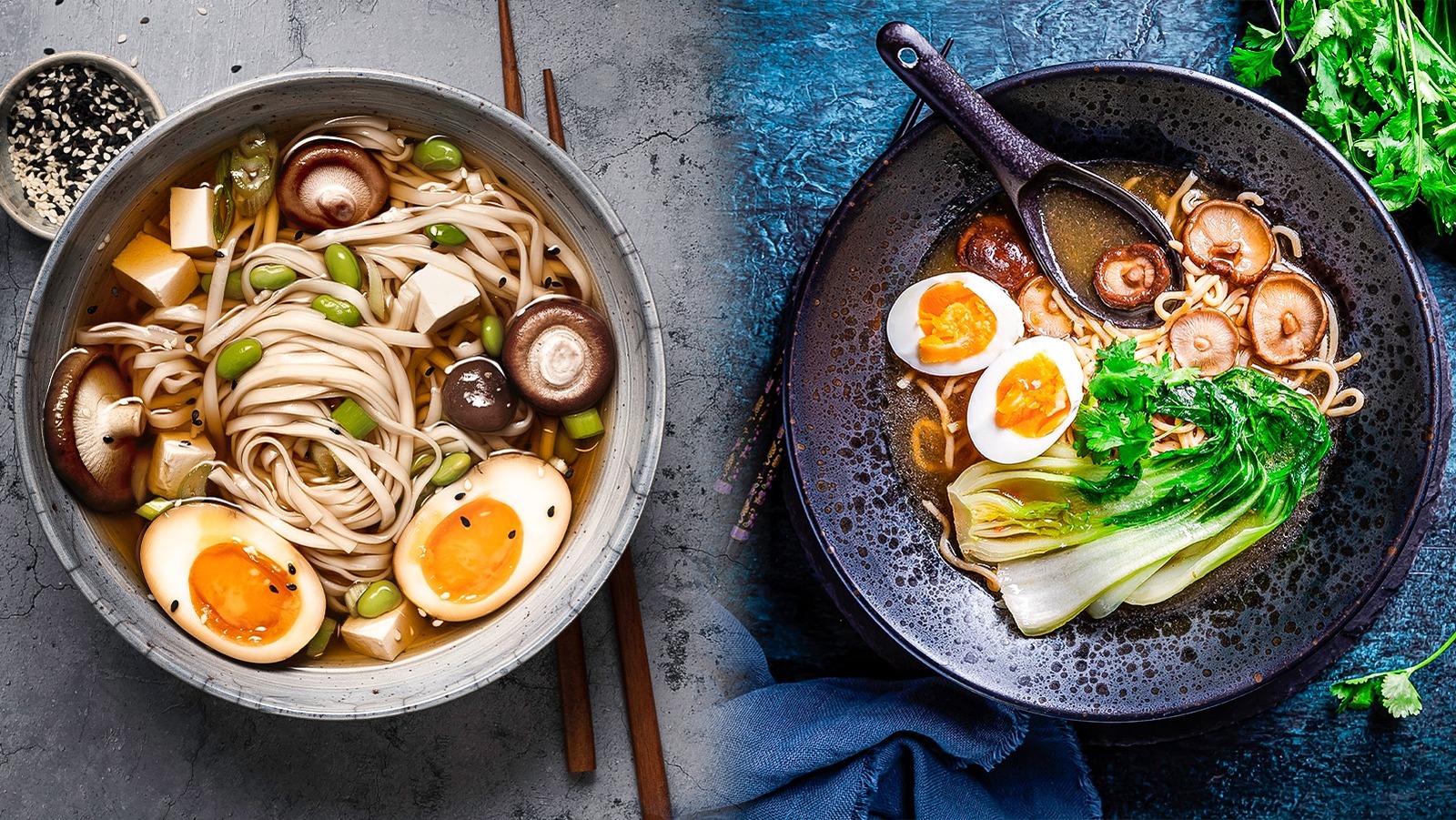Isn’t ramen just wonderful? The broths are simmered to flavor perfection, the noodles are meticulously crafted, and the toppings are ever-expanding. Anytime you want pure comfort, it can be found warmly cradled in a bowl of this traditional Japanese dish. Amongst the many types of ramen out there, shoyu and miso are some of the most beloved. Inevitably, this also means they are occasionally mistaken for one another, their differences blurred in a swirl of umami depth. Even so, each still has its own unique features, and telling the two apart might not be difficult after all.
As extensive as they may seem, ramen broth flavors can be broken down into only three varieties: Shio, shoyu, and miso, or four if you also count the ingredient-based tonkotsu. Shio refers to salt, while shoyu means soy sauce and miso is the famous fermented bean paste. This fundamental difference in ingredients leads to other nuances that separate the two from one another, such as their flavors, colors, and regional variations. Even though both share similar toppings and an umami taste that overlaps with savory, salty, and nutty-sweet notes, they can’t be replaced with one another in any significant way.
What is shoyu ramen?
Shoyu ramen has a well-established history, dating all the way back to the 1900s in Tokyo. It drew inspiration from Chinese wheat noodles but was adapted to fit the Japanese culinary scene at the time. Over time, its influence on the Japanese ramen stratosphere grew more and more, evolving from mere street food to a traditional staple with variations across many regions.
So, what exactly is shoyu ramen made of? This dish is first prepared by simmering a bone broth — often chicken or pork — for hours, then mixing it with the primary flavoring: Shoyu, otherwise known as soy sauce. Along with that, the cook may also add other Japanese staples like dried kelp, dried anchovies, and dashi, and of course, condiments such as mirin and sake. The noodles are often medium-thin, curly strands, with a perfect balance between tender and chewy. The toppings are incredibly diverse. In the protein category, chashu (braised pork belly) and ajitsuke tamago (ramen soft-boiled egg) are common choices. Shiraga negi (sliced green onions) is the go-to pick for veggies, but you might also spot menma (pickled bamboo shoots) and nori (dried seaweeds) as well.
What is miso ramen?
Unlike shoyu ramen, miso ramen is a relatively newer invention, only popularized in the 1960s. It originated from Sapporo — the capital of Hokkaido Prefecture in Japan, presumably as one of the many ways to combat the region’s blistering cold. Over time, it has reached a global status and can easily be found in restaurants and diners beyond Japan.
As the name suggests, miso ramen is made by mixing miso and other condiments into a broth that’s often made from pork bones, dashi, or seafood. The noodles are no different from shoyu ramen, in which the strands are thin and curly. The toppings, however, lean on the heavier, more savory side. You will still undoubtedly find all the usual choices like ajitsuke tamago, menma, and nori, but miso ramen can also be accompanied by ground pork or stir-fried pork belly for extra richness. Sweet corn and bean sprouts are other additions that will also help you recognize miso ramen right away.
Both ramen varieties have different flavorings
The biggest difference between shoyu and miso ramen comes down to their tare (pronounced “tah-reh”), also known as the dish’s seasoning sauce — the deciding factor for how it will taste as well as its salinity. Shoyu ramen centers around a shoyu-based tare. Shoyu is a Japanese soy sauce made from mashed soybeans, wheat grains, and koji (a fungus cultivated from cooked grains) brined with salt and left to ferment before being pasteurized for commercial use. This intricate production process results in a deeply salty, umami flavor profile, with the intensity varying based on how dark the sauce is. For shoyu ramen, in particular, almost any type of shoyu will work, but lighter usukuchi shoyu varieties are preferable to achieve the broth’s signature light hue. It can then be mixed with mirin, sake, kombu, bonito flakes, and other ingredients to make shoyu tare.
Miso ramen is made with a miso tare — a mixture of mirin, sake, sriracha if you want a bit of heat, and of course, miso paste. Miso is a familiar fixture in many households, even beyond the kitchens in Japan, and it’s widely adored for its distinctively funky, concentrated umami taste. This classic condiment starts with a combination of soybeans, salt, and koji that’s left to ferment for months or even years. There are three types of miso, and traditionally, lighter varieties like white or yellow are used for ramen, although red is also an option.
Shoyu and miso ramen have different flavor intensities
If you’ve tasted Japanese soy sauce, you probably have an inkling of shoyu ramen’s flavors — salty but also deeply sweet, quintessentially umami. In between are savory, subtly spiced hints from the accompanying ingredients and the broth’s inherent lightness. It’s complex yet also quite soothing and balanced. Nowadays, certain restaurants will also fuse in creamy elements borrowed from tonkotsu or use beef to inspire a richer depth in this dish. Still, at its core, shoyu ramen is known for its delicate taste and ability to satisfy the palate without weighing it down.
Miso ramen, on the other hand, pulls its hearty, intensely umami flavors from miso. The dark brown, murky, and sometimes thicker broth is a stark distinction from shoyu ramen’s thin opacity, reflecting the dish’s robust essence. Its richness, coupled with the broth’s steaming warmth, is what makes this dish such a beloved comfort food, especially during cold days. As the primary flavors settle, you might also spot sweet and tangy nuances dancing underneath, giving the dish a complexity that lingers beyond the first taste.
Different regions come with different ramen varieties
Shoyu ramen may have a particular tare base, but depending on the region, this dish may be made in numerous ways with subtle differences in ingredients. In Asahikawa, the soy broth includes dried fish, pork bones, and chicken, and is topped with a layer of lard to keep the noodles hot in cold weather. Kitakata, a small town just outside of Tokyo, has a similar version that primarily uses Chinese noodles. Tokyo, in particular, has a unique way of cooking shoyu ramen, in which the broth is never brought to a full boil to maintain its clarity and lightness.
Undoubtedly, miso ramen also comes with its own diverse range of variations, each emphasizing the dish’s hearty richness in a different way. Sapporo ramen—named after its origin city — is a shining example. Its red miso base gives it a deep, dark hue and a salty, umami intensity. The Asahikawa version includes soy sauce, layering in a different type of umami that deepens the ramen’s flavor profile. Some miso ramen recipes also include doubanjiang — a Chinese chili paste that laces the broth with an invigorating kick of heat. This version goes under the name “tantanmen” and is considered a Japanese take on the classic Chinese dan dan noodles, where chili oil plays a starring role. Sometimes, even a simple swap of the noodle variety can flip the textural script on your miso ramen, giving it a whole new spin.





